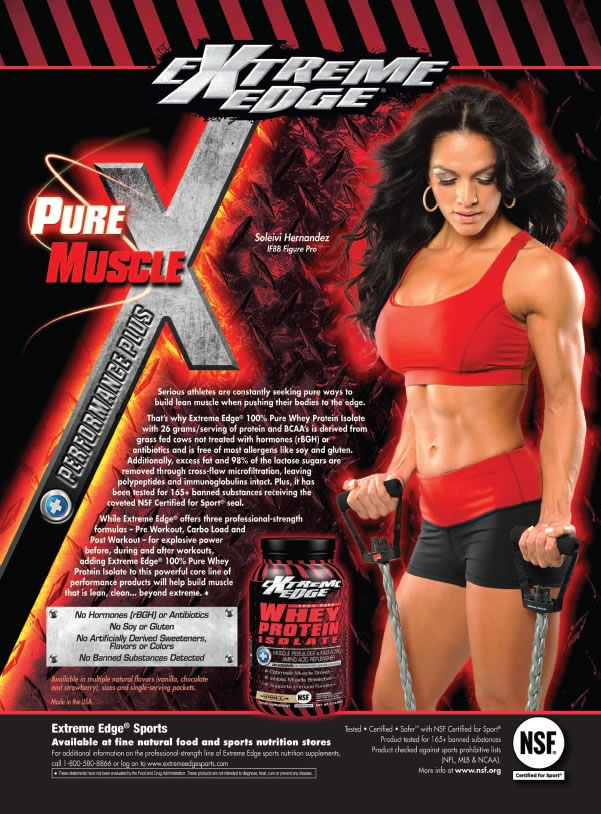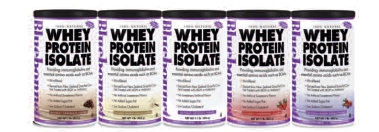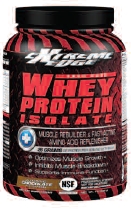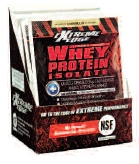Q: What is the importance of protein for serious athletes?
A: Serious athletes need protein to help build lean muscle, support muscle growth and development, and elicit rapid muscle repair since they are continually pushing their bodies to the edge. This is because amino acids are the building blocks of protein, and proteins are the building blocks of muscle. The human body is constantly assembling, breaking down and using proteins on a daily basis. In fact, 10–35% of caloric energy should come from high-quality, complete protein. Whey is considered a complete protein, which contains all the essential and non-essential amino acids. It is naturally rich in  branched chain amino acids (BCAAs)—leucine, isoleucine and valine. These BCAAs must be present in muscle cells to promote protein synthesis, as well as help increase the bioavailability of complex carbohydrates. They are also absorbed by muscle cells to be used as sources of energy to make muscle work more efficiently. Whey protein is highly recommended for athletes and active individuals since it helps in the speedy repair of injured and torn muscles during practice and competition.
branched chain amino acids (BCAAs)—leucine, isoleucine and valine. These BCAAs must be present in muscle cells to promote protein synthesis, as well as help increase the bioavailability of complex carbohydrates. They are also absorbed by muscle cells to be used as sources of energy to make muscle work more efficiently. Whey protein is highly recommended for athletes and active individuals since it helps in the speedy repair of injured and torn muscles during practice and competition.
Q: Why is whey protein isolate (WPI) the protein of choice for bodybuilders and serious athletes?
A: WPI has long been a favorite of bodybuilders and serious athletes since it is the best protein for tissue repair and muscle building. That is because it has the highest biological value (BV) of any protein on the market. BV reflects the quality of the protein, referring to a protein that contains all of the essential amino acids in adequate quantities to sustain growth and development. Proteins with the highest BV are the most potent lean tissue-sparing and growth-promoting proteins.
WPI is considered a fast-acting protein. The concept of “fast” and “slow” acting proteins was first described in the literature by Boirie et al. in 1997. WPI, a protein derived from milk, is considered fast acting because unlike casein, its impact on postprandial (i.e., after eating) protein metabolism is fast, high and transient. These metabolic characteristics of WPI are due in part because it is not coagulated by the gastric juices of the gut, permitting it to be assimilated into the body easily. Simply put, WPI initiates a rapid release of amino acids within the blood, allowing them to be used effortlessly for muscle growth and repair. This is partly because the amino acid profile that makes up WPI is very similar to that of human muscle, making it the protein of choice for bodybuilders and athletes.

Q: Why WPI over whey protein concentrate (WPC)?
A: Whey protein concentrate (WPC) contains 70–80% protein with significant levels of carbohydrate and fat; meanwhile, WPI contains 90–96% protein with minimal lactose (milk sugars) and fat. WPI—like the kind you will find in Extreme Edge 100% Pure Whey Protein Isolate as well as in the Post Workout formula—is preferred over WPC because of the high elemental amount of protein per serving, providing 90% protein per gram of product and ensuring a high concentration of protein in a small dose with minimal levels of fat and lactose. The latter is especially important for those bodybuilders or athletes  who are lactose intolerant and/or who want to minimize fat and carb consumption in order to lean up prior to competition. However, research has shown that WPI in its natural state has biological activity; therefore, manufacturers must take special care to remove lactose and fats without damaging its inherent polypeptides and immunoglobulins. Unlike others who use heat processed WPI, which can denature (render useless) those unique and important intrinsic components in WPI, the nutritional scientists at Extreme Edge employ cross-flow microfiltration, which is a special low-temperature method that leaves the polypeptide chains and immunoglobulins intact. This is important since the latter helps to combat transient immune suppression often caused by strenuous trainings or competition.
who are lactose intolerant and/or who want to minimize fat and carb consumption in order to lean up prior to competition. However, research has shown that WPI in its natural state has biological activity; therefore, manufacturers must take special care to remove lactose and fats without damaging its inherent polypeptides and immunoglobulins. Unlike others who use heat processed WPI, which can denature (render useless) those unique and important intrinsic components in WPI, the nutritional scientists at Extreme Edge employ cross-flow microfiltration, which is a special low-temperature method that leaves the polypeptide chains and immunoglobulins intact. This is important since the latter helps to combat transient immune suppression often caused by strenuous trainings or competition.
Q: Why is WPI important in the recovery process?
A: Recovery nutrition is best thought of as a “window of opportunity.” This is because studies suggest that within 30 minutes after intense exercise, the body optimizes its ability to replenish energy stores—particularly muscle and liver glycogen. Basically, the body becomes a sponge, and for athletes, this is the golden opportunity to optimize muscle rebuilding and recovery if the right ingredients are available.  Protein intake after exercise should be between 20 and 40 grams (both Extreme Edge 100% Pure Whey Protein Isolate and Post Workout provide 26 g/serving) and should be consumed within one to three hours after exercise for optimal use by the body. Protein also helps to reduce delay onset muscle soreness in athletes who achieve muscle failure (infamously seen in bodybuilders).
Protein intake after exercise should be between 20 and 40 grams (both Extreme Edge 100% Pure Whey Protein Isolate and Post Workout provide 26 g/serving) and should be consumed within one to three hours after exercise for optimal use by the body. Protein also helps to reduce delay onset muscle soreness in athletes who achieve muscle failure (infamously seen in bodybuilders).
Recommendations from the American College of Sports Medicine, Academy of Nutrition and Dietetics and DC include consuming carbohydrates (CHO) within 30 minutes after exercise at a rate of 0.8–1.0 g/kg/h during recovery for four hours or more to improve athletic performance. However, the recommended CHO:protein ratio of 3:1 is typical for endurance athletes. For extreme bodybuilders, it has been hypothesized that the reverse—about 3:1 protein:CHO—may be more beneficial as it supports the growth and development of lean muscle and allows for body fat to melt right off the physique.
Additionally, it should be noted that these organizations also recognize higher protein (e.g., 1.6–1.7 grams/kg/day [a 155-lb (70 kg) male would need 112–119 grams daily]) needs for muscle repair and a more anabolic hormonal profile for intense resistance trained athletes, which is why it may be necessary to have a standalone whey protein product like that found with Extreme Edge’s Whey Protein Isolate. Getting the necessary protein to support intense muscle gains can be difficult and by consuming a standalone whey protein in the morning and then adding it to a recovery formula like the Extreme Edge Post Workout Formula will make it easier to achieve these high macronutrient levels.
be necessary to have a standalone whey protein product like that found with Extreme Edge’s Whey Protein Isolate. Getting the necessary protein to support intense muscle gains can be difficult and by consuming a standalone whey protein in the morning and then adding it to a recovery formula like the Extreme Edge Post Workout Formula will make it easier to achieve these high macronutrient levels.
References
Boirie Y, Dangin M, Gachon P, Vasson MP, Maubois JL, Beaufrere B, “Slow and Fast Dietary Proteins Differently Modulate Postprandial Protein Accretion,” Proc. Nat. Acad. Sci. USA 1997 Dec 23; 94(26), 14930–14935.
Bounous G, Gold P, “The Biological Activity of Undenatured Dietary Whey Proteins: Role of Glutathione,” Clin. Invest. Med. 1991 Aug; 14(4), 296–309.
Dangin M, Boirie Y, Guillet C, Beaufrere B, “Influence of the Protein Digestion Rate on Protein Turnover in Young and Elderly Subjects,” J. Nutr. 2002 Oct; 132(10), 3228S–333S.
Freund HR, Hanani M, “The Metabolic Role of Branched-Chain Amino Acids,” Nutrition. 2002 Mar; 18(3), 287–288.

Trisha Sugarek MacDonald holds a Master of Science in Nutrition from Texas Woman’s University and also a Bachelor of Science Degree in Nutrition and Foods from Texas State University. Mrs. MacDonald is currently the Director of Research & Development as well as the National Educator at Bluebonnet Nutrition where she investigates new ingredients, directs the launch of new products, and provides industry training on numerous subjects as it relates to the connection between nutrition and health. She is a frequent editorial contributor and lecturer on the benefits surrounding the responsible use of supplements.
Published in WholeFoods Magazine, August 2013










